Explanation of the PLC Effect in Advanced High-Strength Medium-Mn Steels. A Review
Abstract
1. Introduction
2. The Nature of PLC Effect in Steels
3. Theories Explaining the PLC Mechanism in Medium- and High-Manganese Steels
3.1. Effect of Twinning-Induced Plasticity (TWIP) on Plastic Instability Phenomenon
3.2. Effect of Transformation-Induced Plasticity (TRIP) on Plastic Instability Phenomenon
4. The PLC Effect in Medium-Manganese Steels
4.1. Cold-Rolled Medium-Mn Steels
4.2. Hot-Rolled Medium-Mn Steels
5. Effect of Deformation Temperature on the PLC Effect
6. Effect of Strain Rate on the PLC Effect
7. Conclusions
- Reduction of carbon and manganese contents. It results in a smaller amount of C–Mn pairs, which interact dynamically with dislocations during deformation.
- Addition of elements which form carbides. Carbide precipitation decreases the concentration of interstitial atoms in solid solution, terminating the DSA. The lower carbon content due to carbide precipitation requires a larger strain to trigger the PLC effect.
- Reduction in grain size. The dislocation density increases more slowly in fine-grained austenite grains. Hence, the amount of dislocations cannot be high enough to induce the PLC band formation.
- Application of hot rolling rather than cold rolling. Hot-rolled steel grades are not prone to Lüders band formation due to the presence of mobile dislocations generated during thermomechanical processing.
- Increasing the strain rate during deformation. It reduces interaction time between dislocations and carbon atoms C–Mn clusters. Thus, it can significantly reduce the PLC effect. However, applying a high deformation rate results in the higher stability of retained austenite because of adiabatic heating, which stimulates the lower intensity of the TRIP effect.
Funding
Acknowledgments
Conflicts of Interest
References
- Cottrell, A.H. A note on the Portevin-le Chatelier effect. Lond. Edinb. Dublin Philos. Mag. J. Sci. 1953, 44, 829–832. [Google Scholar] [CrossRef]
- Meng, X.; Liu, B.; Luo, L.; Ding, Y.; Rao, X.X.; Hu, B.; Liu, Y.; Lu, J. The Portevin-Le Chatelier effect of gradient nanostructured 5182 aluminum alloy by surface mechanical attrition treatment. J. Mater. Sci. Technol. 2018, 34, 2307–2315. [Google Scholar] [CrossRef]
- Kang, J.; Wilkinson, D.S.; Embury, J.D.; Mukesh, J.; Beaudoin, A.J. Effect of type-B Portevin-Le Chatelier bands on the onset of necking in uniaxial tension of strip cast AA5754 sheets. Scr. Mater. 2005, 53, 499–503. [Google Scholar] [CrossRef]
- Ozgowicz, W.; Grzegorczyk, B.; Pawełek, A.; Wajda, W.; Skuza, W.; Piątkowski, A.; Ranachowski, Z. An analysis of the Portevin-Le Chatelier effect and cracking of CuSn6P alloy at elevated temperature of deformation applying the acoustic emission method. Eng. Fract. Mech. 2016, 167, 112–122. [Google Scholar] [CrossRef]
- Härtel, M.; Illgen, C.; Frint, P.; Wagner, F.M.X. On the PLC effect in a particle reinforced AA2017 alloy. Metals 2018, 8, 88. [Google Scholar] [CrossRef]
- Yang, F.; Luo, H.; Pu, H.; Zhang, S.; Dong, H. On the characteristics of Portevin-Le Chatelier bands in cold-rolled 7Mn steel showing transformation-induced plasticity. Int. J. Plast. 2018, 103, 188–202. [Google Scholar] [CrossRef]
- Kipelova, A.; Kaibyshev, R.; Skorobogatykh, V.; Schenkova, I. Portevin-Le Chatelier effect in an E911 creep resistant steel with 3% Co additives. J. Phys. Conf. Ser. 2010, 240. [Google Scholar] [CrossRef]
- Koyama, M.; Sawaguchi, T.; Tsuzaki, K. Overview of dynamic strain aging and associated phenomena in Fe–Mn–C austenitic steels. ISIJ Int. 2018, 58, 187–200. [Google Scholar] [CrossRef]
- Ranc, N.; Du, W.; Ranc, I.; Wagner, D. Experimental studies of Portevin-Le Chatelier plastic instabilities in carbon-manganese steels by infrared pyrometry. Mater. Sci. Eng. A 2016, 663, 166–173. [Google Scholar] [CrossRef]
- Min, J.; Hector, L.G., Jr.; Zhang, L.; Sund, L.; Carsley, J.E.; Lin, J. Plastic instability at elevated temperatures in a TRIP-assisted steel. Mater. Des. 2016, 95, 370–386. [Google Scholar] [CrossRef]
- Liu, C.; Peng, Q.; Xue, Z.; Deng, M.; Wang, S.; Yang, C. Microstructure-tensile properties relationship and austenite stability of a Nb-Mo micro-alloyed medium-Mn TRIP steel. Metals 2018, 8, 615. [Google Scholar] [CrossRef]
- Suh, W.D.; Kim, S.J. Medium Mn transformation-induced plasticity steels: Recent progress and challenges. Scr. Mater. 2017, 126, 63–67. [Google Scholar] [CrossRef]
- Wang, X.G.; Wang, L.; Huang, M.X. Kinematic and thermal characteristics of Lüders and Portevin-Le Chatelier bands in a medium Mn transformation-induced plasticity steel. Acta Mater. 2017, 124, 17–29. [Google Scholar] [CrossRef]
- Mc Cormick, P.G. The inverse Portevin-Le Chatelier effect in an Al-Mn-Si alloy. Scr. Metall. 1972, 6, 165–170. [Google Scholar] [CrossRef]
- Penning, P. Mathematics of the Portevin-Le Chatelier effect. Acta Mater. 1972, 20, 1169. [Google Scholar] [CrossRef]
- Brindley, B.J.; Worthington, P.J. Reply to “on the grain-size dependence of activation energy associated with serrated yielding”. Scr. Metall. 1970, 4, 295–297. [Google Scholar] [CrossRef]
- De Oliveira, M.M.; Couto, A.A.; Almeida, G.F.C.; Reis, D.A.P.; de Lima, N.B.; Baldan, R. Mechanical behavior of inconel 625 at elevated temperatures. Metals 2019, 9, 301. [Google Scholar] [CrossRef]
- Maj, P.; Zdunek, J.; Gizynski, M.; Mizera, J.; Kurzydlowski, K.J. Statistical analysis of the Portevin-Le Chatelier effect in Inconel 718 at high temperature. Mater. Sci. Eng. A 2014, 619, 158–164. [Google Scholar] [CrossRef]
- Sarkar, A.; Maloy, S.A.; Murty, K.L. Investigation of Portevin Le Chatelier effect in HT-9 steel. Mater. Sci. Eng. A 2015, 631, 120–125. [Google Scholar] [CrossRef]
- Muhamed, G.A.; Gunduz, S.; Erden, M.A.; Tastemur, D. Dynamic Strain Aging behaviour in AISI 316L austenitic stainless steel under as-received and as-welded conditions. Metals 2017, 7, 362. [Google Scholar] [CrossRef]
- Owen, W.S.; Grujicic, M. Strain ageing of austenitic Hadfield manganese steel. Acta Metall. 1999, 47, 111–126. [Google Scholar]
- Sachdev, A.K. Dynamic strain aging of various steels. Metall. Trans. A 1982, 13, 1793–1797. [Google Scholar] [CrossRef]
- Hickel, T.; Sandlöbes, S.; Marceau, R.K.W.; Dick, A.; Bleskov, I.; Neugebauer, J.; Raabe, D. Impact of nanodiffusion on the stacking fault energy in high-strength steels. Acta Mater. 2014, 75, 147–155. [Google Scholar] [CrossRef]
- Medvedeva, N.I.; Park, M.S.; Van Aken, D.C.; Medvedeva, J.E. First-principles study of Mn, Al and C distribution and their effect on stacking fault energies in fcc Fe. J. Alloy. Compd. 2014, 582, 475–482. [Google Scholar] [CrossRef]
- Kang, J.H.; Ingendahl, T.; von Appen, J.; Dronskowski, R.; Bleck, W. Impact of short-range ordering on yield strength of high manganese austenitic steels. Mater. Sci. Eng. A 2014, 614, 122–128. [Google Scholar] [CrossRef]
- Seol, J.B.; Kim, J.G.; Na, S.H.; Park, C.G.; Kim, H.S. Deformation rate controls atomic-scale dynamic strain aging and phase transformation in high Mn TRIP steels. Acta Mater. 2017, 131, 187–196. [Google Scholar] [CrossRef]
- Kim, J.G.; Hong, S.; Anjabin, N.; Park, B.H.; Kim, S.H.; Chin, H.G.; Lee, S.; Kim, H.S. Dynamic strain aging of twinning-induced plasticity (TWIP) steel in tensile testing and deep drawing. Mater. Sci. Eng. A 2015, 633, 136–143. [Google Scholar] [CrossRef]
- Lebedkina, T.A.; Lebyodkin, M.A.; Chateau, J.P.; Jacques, A.; Allain, S. On the mechanism of unstable plastic flow in an austenitic FeMnC TWIP steel. Mater. Sci. Eng. A 2009, 519, 147–154. [Google Scholar] [CrossRef]
- Lee, S.; De Cooman, B. Tensile behavior of intercritically annealed 10 pct Mn multi-phase steel. Metall. Mater. Trans. A 2014, 45, 709–716. [Google Scholar] [CrossRef]
- Grzegorczyk, B.; Kozłowska, A.; Morawiec, M.; Muszyński, R.; Grajcar, A. Effect of deformation temperature on the Portevin-Le Chatelier effect in medium-Mn steel. Metals 2018, 9, 2. [Google Scholar] [CrossRef]
- Sevsek, S.; Brasche, F.; Haase, C.; Bleck, W. Combined deformation twinning and short-range ordering causes serrated flow in high-manganese steels. Mater. Sci. Eng. A 2019, 746, 434–442. [Google Scholar] [CrossRef]
- Jung, I.C.; De Cooman, B.C. Temperature dependence of the flow stress of Fe–18Mn–0.6C–xAl twinning-induced plasticity steel. Acta Mater. 2013, 61, 6724–6735. [Google Scholar] [CrossRef]
- Koyama, M.; Sawaguchi, T.; Tsuzaki, K. Deformation twinning behavior of twinning induced plasticity steels with different carbon concentrations—Part 2: Proposal of dynamic-strain-aging-assisted deformation twinning. ISIJ Int. 2015, 55, 1754–1761. [Google Scholar] [CrossRef]
- Song, W.; Houston, J.E. Local deformation and Mn-C short-range ordering in a high-Mn Fe-18Mn-0.6C steel. Metals 2018, 8, 292. [Google Scholar] [CrossRef]
- Song, W.; Bogdanovski, D.; Yildiz, A.B.; Houston, J.E.; Dronskowski, R.; Bleck, W. On the Mn–C short-range ordering in a high-strength high-ductility steel: Small angle neutron scattering and Ab initio investigation. Metals 2018, 8, 44. [Google Scholar] [CrossRef]
- Madivala, M.; Schwedt, A.; Prahl, U.; Bleck, W. Strain hardening, damage and fracture behavior of Al-added high Mn TWIP steels. Metals 2019, 9, 367. [Google Scholar] [CrossRef]
- Allain, S.; Bouaziz, O.; Lebedkina, T.; Lebyodkin, M. Relationship between relaxation mechanisms and strain aging in an austenitic FeMnC steel. Scr. Mater. 2011, 64, 741–744. [Google Scholar] [CrossRef]
- Gutierrez-Urrutia, I.; Raabe, D. Dislocation density measurement by electron channeling contrast imaging in a scanning electron microscope. Scr. Mater. 2012, 66, 343–346. [Google Scholar] [CrossRef]
- Field, D.M.; Van Aken, D.C. Dynamic strain ageing phenomena and tensile response of medium-Mn TRIP steel. Metall. Mater. Trans. A 2018, 49A, 1152–1166. [Google Scholar] [CrossRef]
- Callahan, M.; Hubert, O.; Hild, F.; Perlade, A.; Schmitt, J.H. Coincidence of strain-induced TRIP and propagative PLC bands in medium Mn steels. Mater. Sci. Eng. A 2017, 703, 391–400. [Google Scholar] [CrossRef]
- Sun, B.; Vanderesse, N.; Fazeli, F.; Scott, C.; Chen, J.; Bocher, P.; Jahazi, M.; Yue, S. Discontinuous strain-induced martensite transformation related to the Portevin-Le Chatelier effect in a medium manganese steel. Scr. Mater. 2017, 133, 9–13. [Google Scholar] [CrossRef]
- Ryu, J.H.; Kim, J.I.; Kim, H.S.; Oh, C.S.; Bhadeshia, H.K.D.H.; Suh, D.W. Austenite stability and heterogeneous deformation in fine-grained transformation induced plasticity-assisted steel. Scr. Mater. 2013, 68, 933–936. [Google Scholar] [CrossRef]
- Cai, Z.H.; Ding, H.; Misra, R.D.K.; Qiguan, S.Q. Mechanistic contribution of the interplay between microstructure and plastic deformation in hot-rolled Fe–11Mn–2/4Al–0.2C steel. Mater. Sci. Eng. A 2016, 652, 205–211. [Google Scholar] [CrossRef]
- Cai, Z.H.; Ding, H.; Misra, R.D.K.; Ying, Z.Y. Austenite stability and deformation behavior in a cold-rolled transformation-induced plasticity steel with medium manganese content. Acta Mater. 2015, 84, 229–236. [Google Scholar] [CrossRef]
- Gibbs, P.J.; De Moor, E.; Merwin, M.J.; Clausen, B.; Speer, J.G.; Matlock, D.K. Austenite stability effects on tensile behavior of manganese-enriched-austenite transformation-induced plasticity steel. Metall. Mater. Trans. A 2011, 42, 3691–3702. [Google Scholar] [CrossRef]
- Grajcar, A.; Skrzypczyk, P.; Woźniak, D. Thermomechanically rolled medium-Mn steels containing retained austenite. Arch. Metall. Mater. 2014, 59, 1691–1697. [Google Scholar] [CrossRef]
- Sevsek, S.; Haase, C.; Bleck, W. Strain-rate-dependent deformation behavior and mechanical properties of a multi-phase medium-manganese steel. Metals 2019, 9, 344. [Google Scholar] [CrossRef]
- Wang, Y.; Ma, Z.; Song, R.; Zhao, S.; Zhang, Z.; Huo, W. Correlation between cementite precipitation and Portevin-Le Chatelier effect in a hot-rolled medium Mn steel. Mater. Lett. 2020, 258. [Google Scholar] [CrossRef]
- Rusinek, A.; Klepaczko, J.R. Experiments on heat generated during plastic deformation and stored energy for TRIP steels. Mater. Des. 2009, 30, 35–48. [Google Scholar] [CrossRef]
- Aydemir, B.; Zeytin, H.K.; Guven, G. Investigations of Portevin-Le Chatelier (PLC) effect of hot-rolled Fe-13Mn-0.2C-1Al-1Si TWIP steel. Mater. Tehnol. 2016, 50, 511–516. [Google Scholar] [CrossRef]
- Rahmaan, T.; Bardelcik, A.; Imbert, J.; Butcher, C.; Worswick, M.J. Effect of strain rate on flow stress and anisotropy of DP600, TRIP780, and AA5182-O sheet metal alloys. Int. J. Impact Eng. 2016, 88, 72–90. [Google Scholar] [CrossRef]
- Callahan, M.; Perlade, A.; Schmitt, J.H. Interactions of negative strain rate sensitivity, martensite transformation, and dynamic strain aging in 3rd generation advanced high-strength steels. Mater. Sci. Eng. A 2019, 754, 140–151. [Google Scholar] [CrossRef]
- Xing, J.; Hou, L.; Du, H.; Liu, B.; Wei, Y. A new explanation for the effect of dynamic strain aging on negative strain rate sensitivity in Fe–30Mn–9Al–1C steel. Materials 2019, 12, 3426. [Google Scholar] [CrossRef] [PubMed]

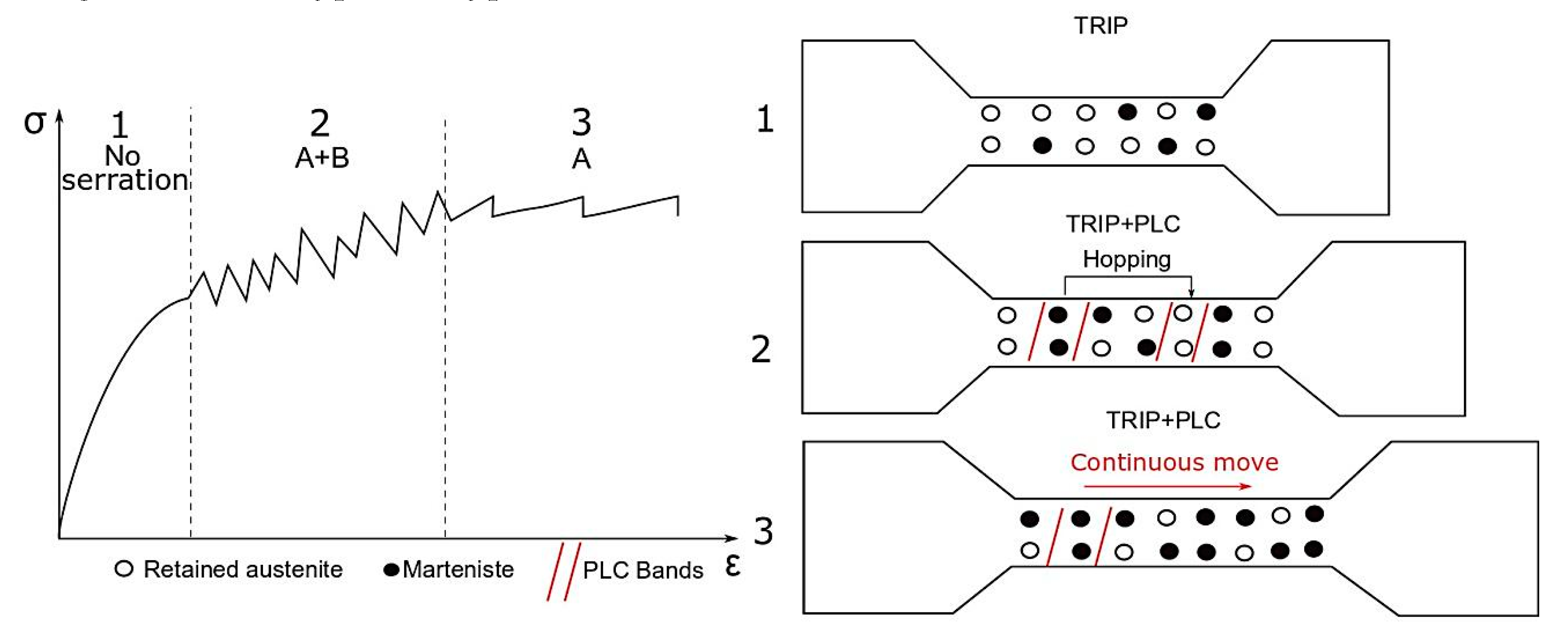
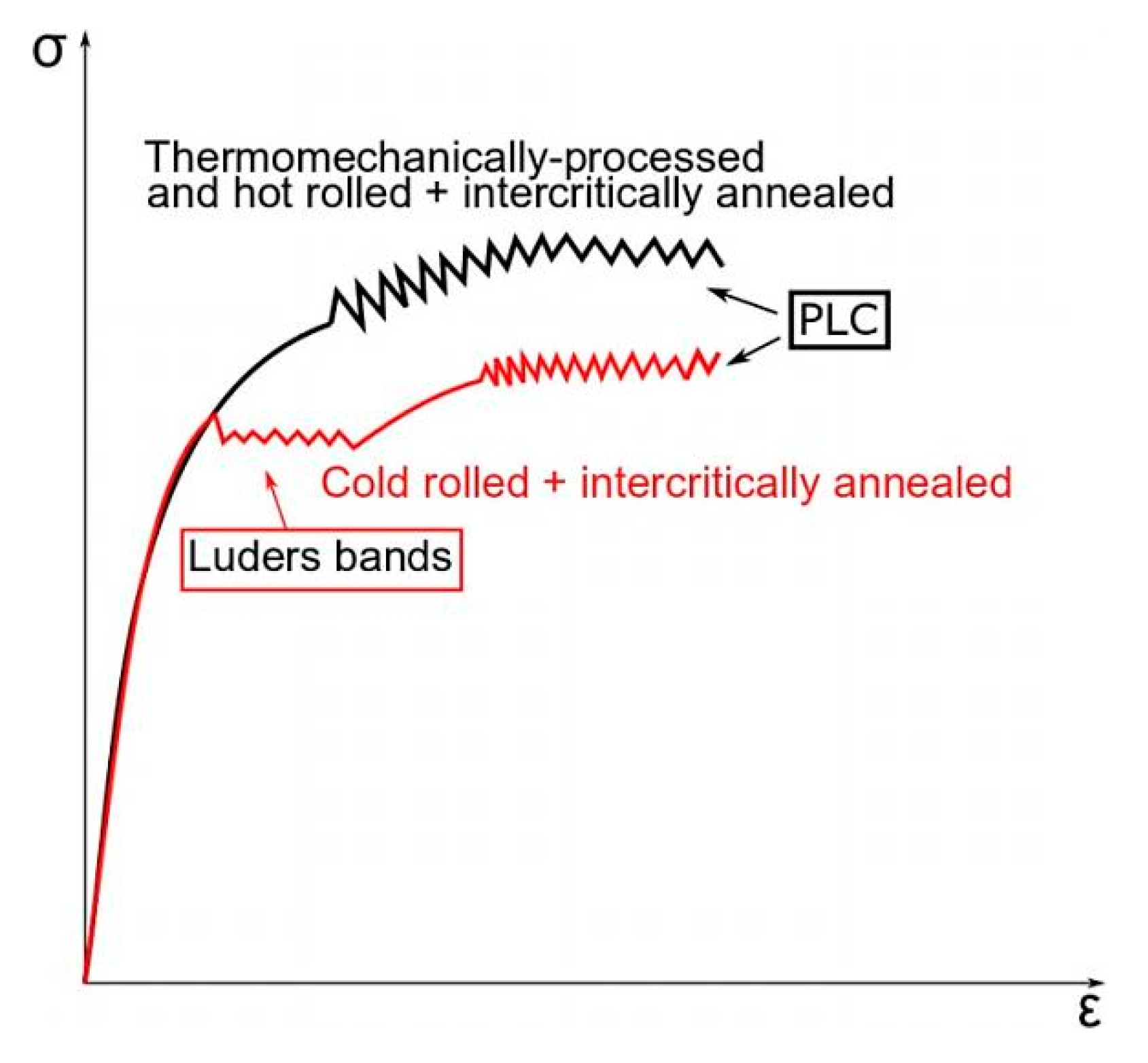
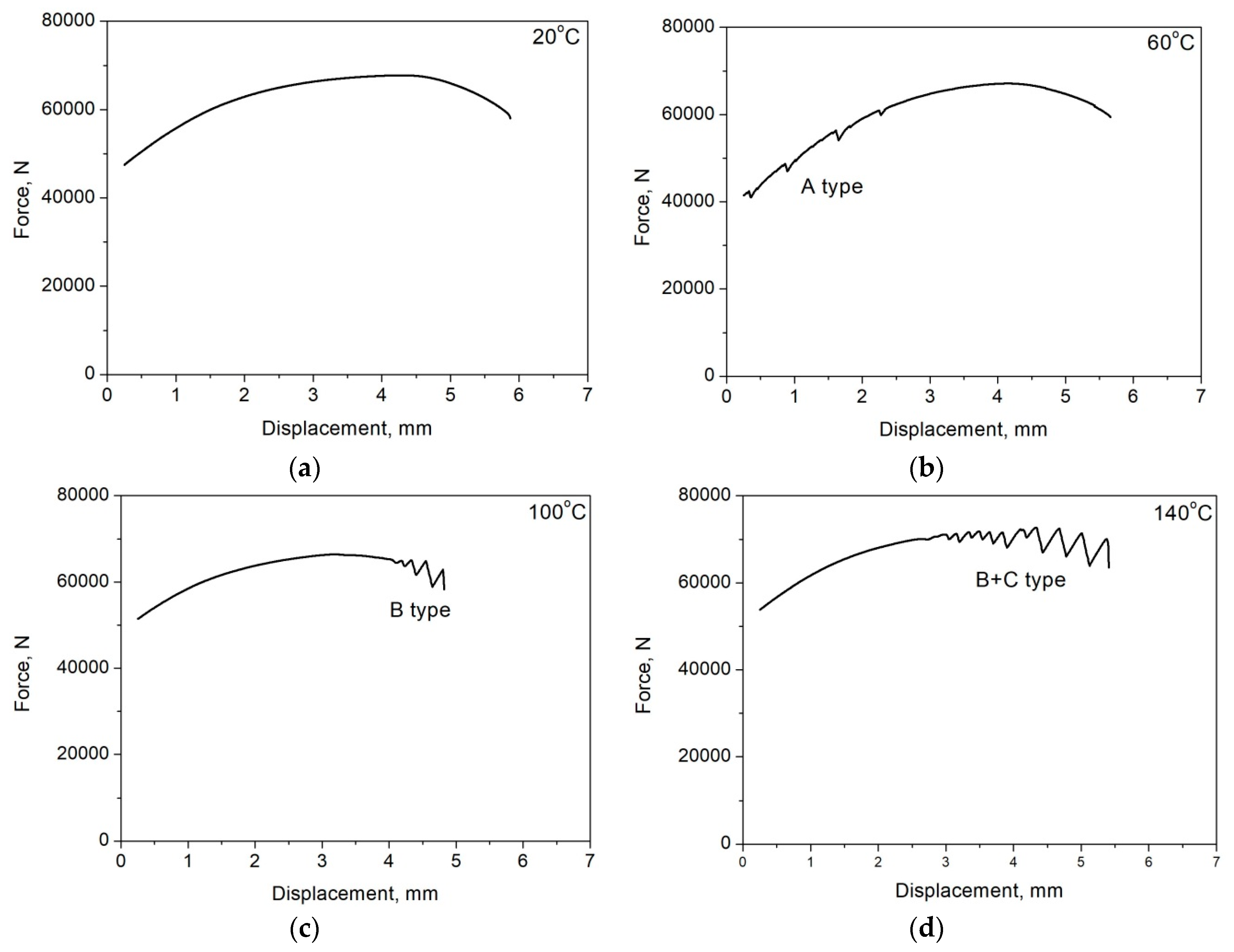
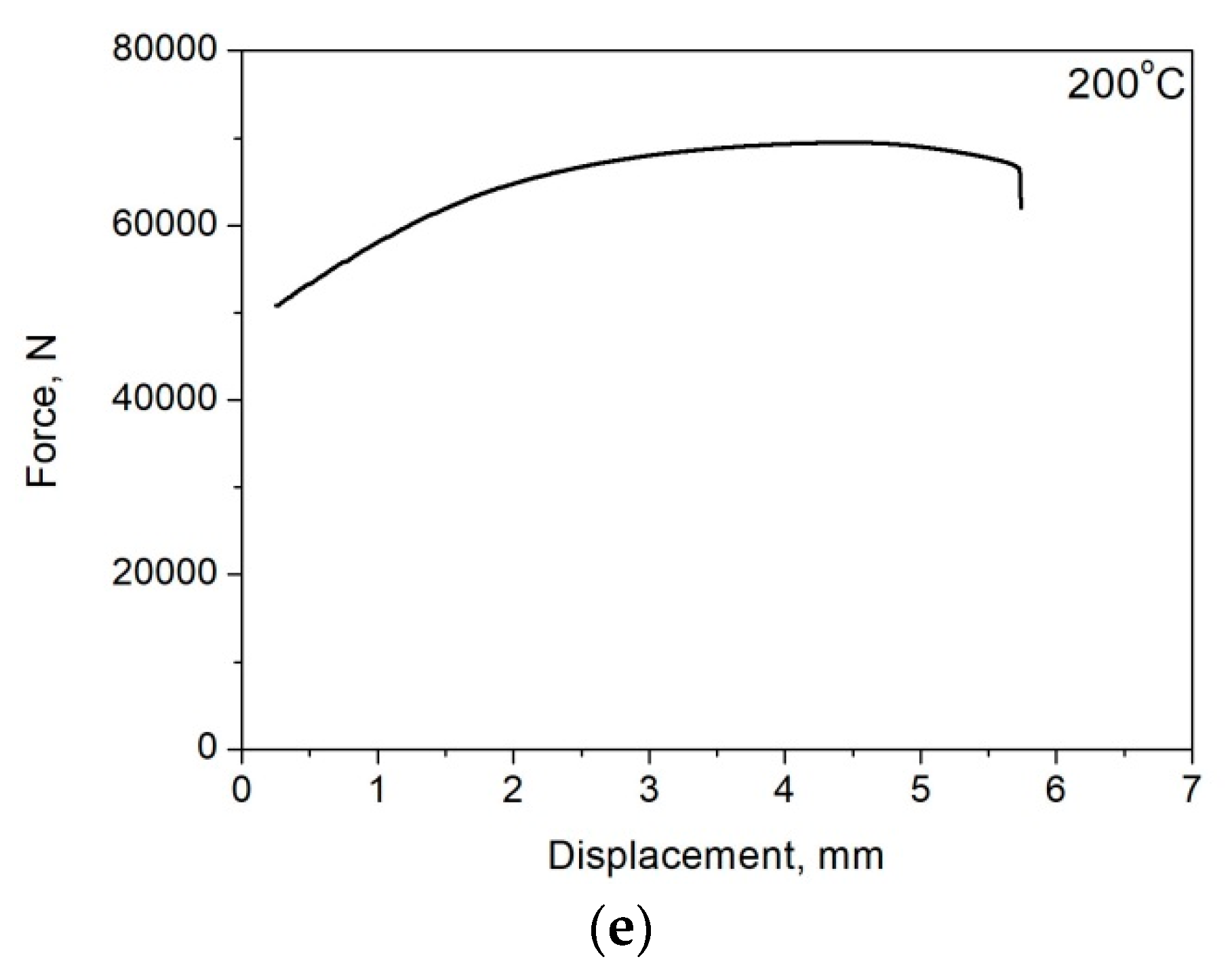
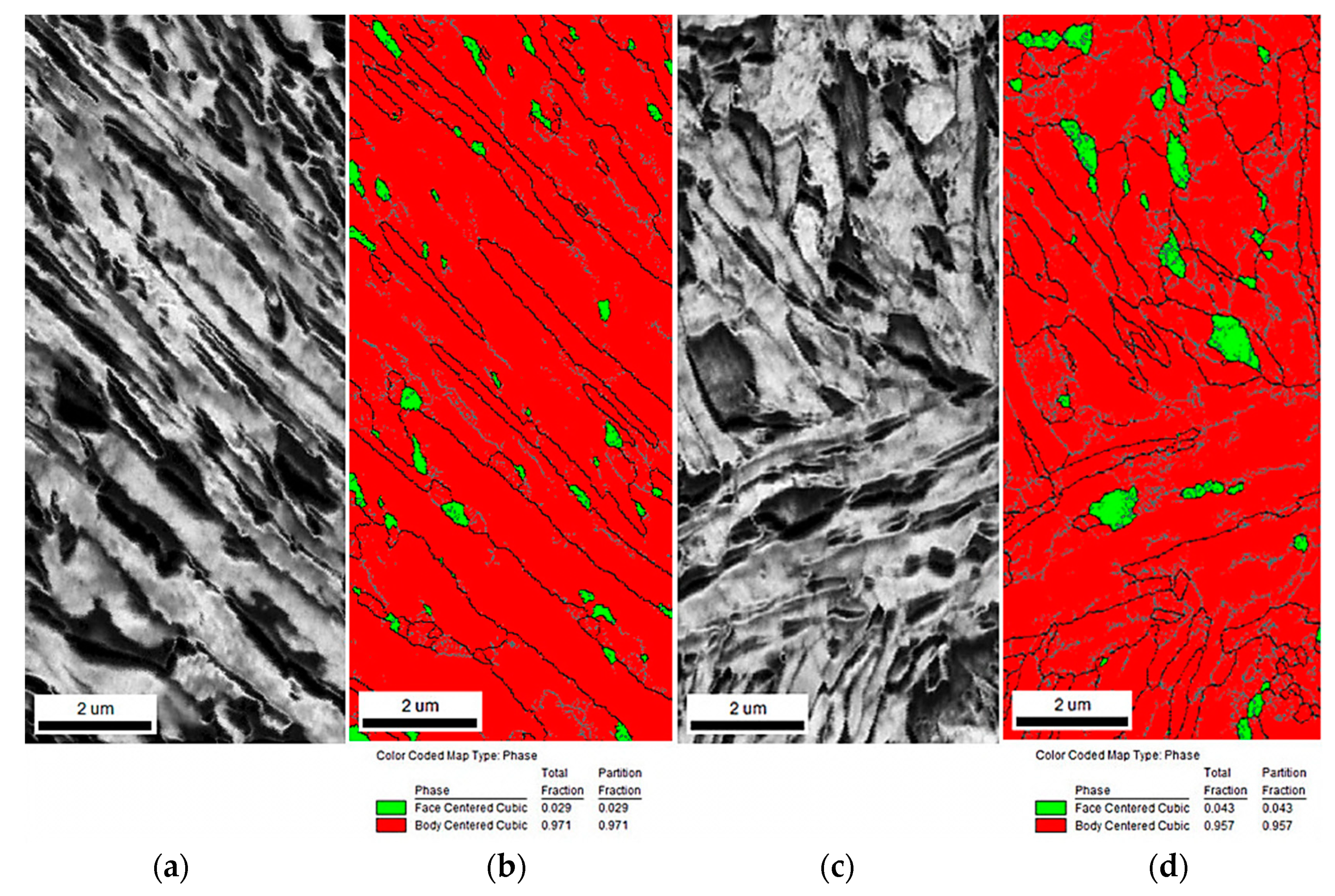
| Type of Steel. | Critical Strain, % | Deformation Temperature, °C | Strain Rate s−1 | Microstructure | Reference |
|---|---|---|---|---|---|
| 0.18C–17Mn | ~12 | room temperature | 10−4 | austenite+martensite | [26] |
| 0.18C–17Mn | ~15 | room temperature | 10−3 | austenite+martensite | [26] |
| 0.18C–17Mn | ~16 | room temperature | 10−2 | austenite+martensite | [26] |
| 0.6C–22Mn | ~5 | room temperature | 10−3 | austenite | [27] |
| 0.6C–18Mn | ~15 | room temperature | 10−3 | austenite | [27] |
| 0.6C–18Mn–2Al | no serrations | room temperature | 10−3 | austenite | [27] |
| 0.3C–17Mn–1Al | 25 | 150 | 25 × 10−3 | austenite | [28] |
| 0.6C–18Mn | 5 | 150 | 25 × 10−3 | austenite | [28] |
| 0.6–18Mn | 3 | room temperature | 25 × 10−3 | austenite | [28] |
| 0.2C–2Mn–1.4Si | ~5 | 100 | 5 × 10−5 | ferrite+martensite+ retained austenite | [10] |
| 0.2C–2Mn–1.4Si | no serrations | 200 | 5 × 10−5 | ferrite+martensite+ retained austenite | [10] |
| 0.3C–7Mn–2Al | ~10 | −50 | 6.67 × 10−4 | ferrite+austenite | [7] |
| 0.3C–7Mn–2Al | ~25 | 27 | 6.67 × 10−4 | ferrite+austenite | [7] |
| 0.3C–10Mn–3Al–2Si | 43 | room temperature | 10−3 | ferrite+austenite | [29] |
| 0.3C–9Mn–2Al | ~10 | room temperature | 10−3 | ferrite+austenite | [29] |
| 0.16C–5Mn–1.6Al | ~1 | 60 | 10−3 | bainite+retained austenite | [30] |
| 0.16C–5Mn–1.6Al | ~8 | 100 | 10-3 | bainite+retained austenite | [30] |
| 0.16C–5Mn–1.6Al | ~6 | 140 | 10-3 | bainite+retained austenite | [30] |
© 2019 by the authors. Licensee MDPI, Basel, Switzerland. This article is an open access article distributed under the terms and conditions of the Creative Commons Attribution (CC BY) license (http://creativecommons.org/licenses/by/4.0/).
Share and Cite
Kozłowska, A.; Grzegorczyk, B.; Morawiec, M.; Grajcar, A. Explanation of the PLC Effect in Advanced High-Strength Medium-Mn Steels. A Review. Materials 2019, 12, 4175. https://doi.org/10.3390/ma12244175
Kozłowska A, Grzegorczyk B, Morawiec M, Grajcar A. Explanation of the PLC Effect in Advanced High-Strength Medium-Mn Steels. A Review. Materials. 2019; 12(24):4175. https://doi.org/10.3390/ma12244175
Chicago/Turabian StyleKozłowska, Aleksandra, Barbara Grzegorczyk, Mateusz Morawiec, and Adam Grajcar. 2019. "Explanation of the PLC Effect in Advanced High-Strength Medium-Mn Steels. A Review" Materials 12, no. 24: 4175. https://doi.org/10.3390/ma12244175
APA StyleKozłowska, A., Grzegorczyk, B., Morawiec, M., & Grajcar, A. (2019). Explanation of the PLC Effect in Advanced High-Strength Medium-Mn Steels. A Review. Materials, 12(24), 4175. https://doi.org/10.3390/ma12244175






